Abstract
Under photoautotrophic growth conditions, the marine cyanobacterium Agmenellum quadruplicatum PR-6 metabolized phenanthrene to form trans-9,10-dihydroxy-9,10-dihydrophenanthrene (phenanthrene trans-9,10-dihydrodiol) and 1-methoxyphenanthrene as the major ethyl acetate-extractable metabolites. Small amounts of phenanthrols were also formed. The metabolites were purified by high-pressure liquid chromatography and identified from their UV, infrared, mass, and proton magnetic resonance spectral properties. A. quadruplicatum PR-6 formed phenanthrene trans-9,10-dihydrodiol with a 22% enantiomeric excess of the (-)-9S,10S-enantiomer. Incorporation experiments with 18O2 showed that one atom of oxygen from O2 was incorporated into the dihydrodiol. Toxicity studies, using an algal lawn bioassay, indicated that 9-phenanthrol and 9,10-phenanthrenequinone inhibit the growth of A. quadruplicatum PR-6.
Full text
PDF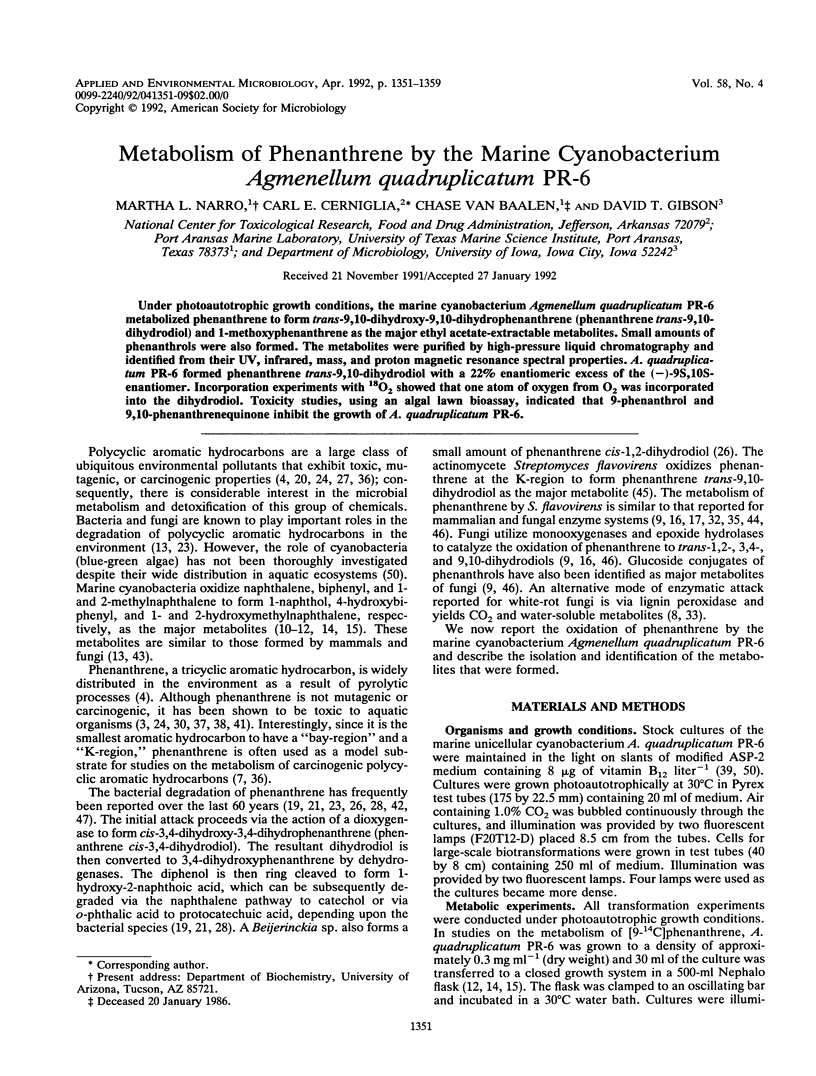
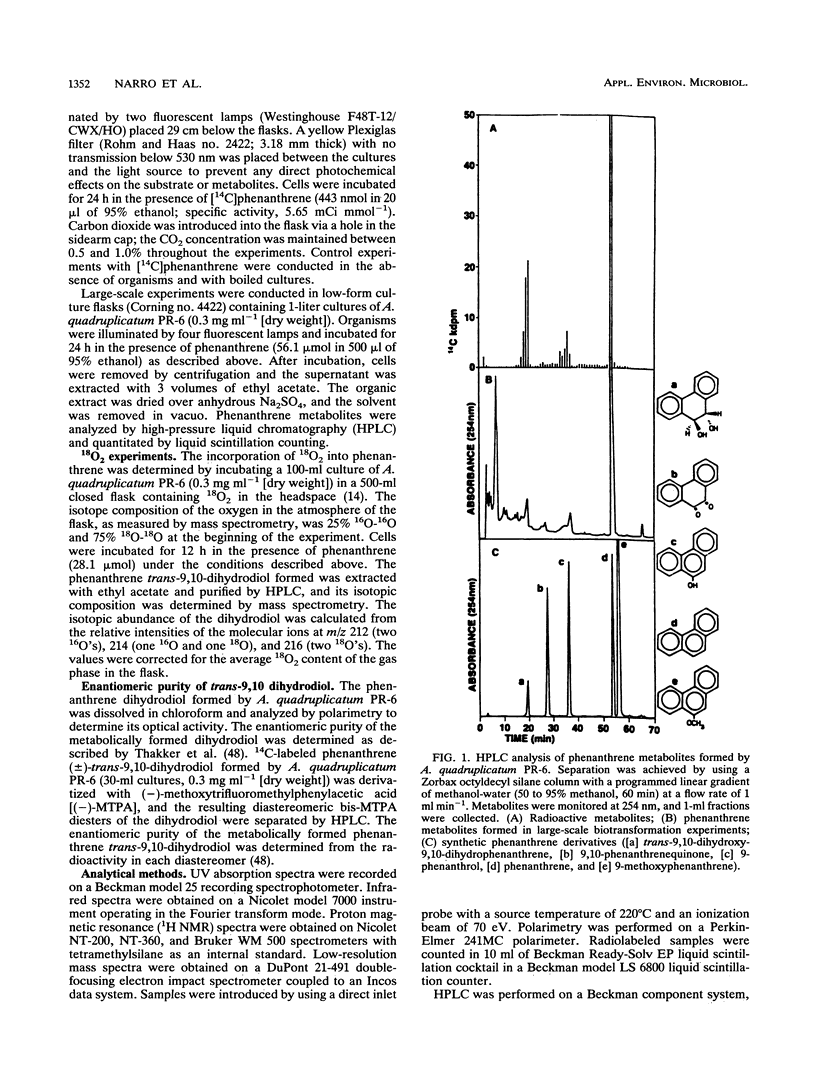
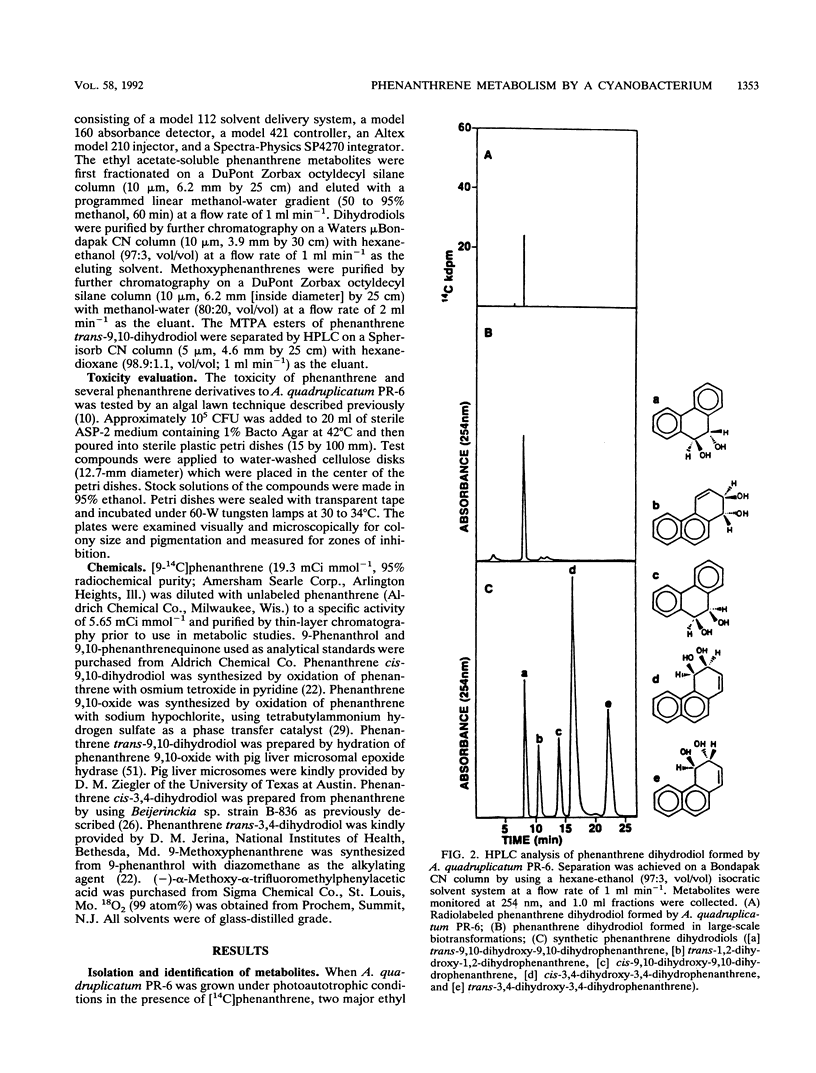
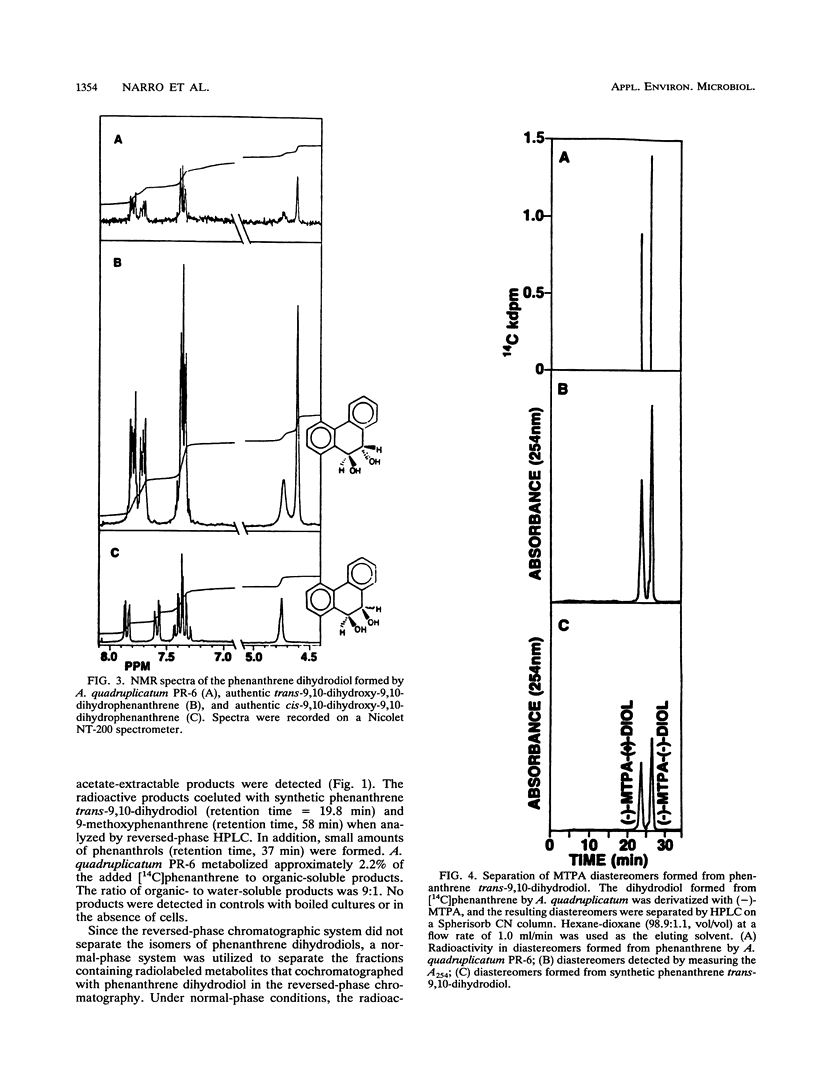
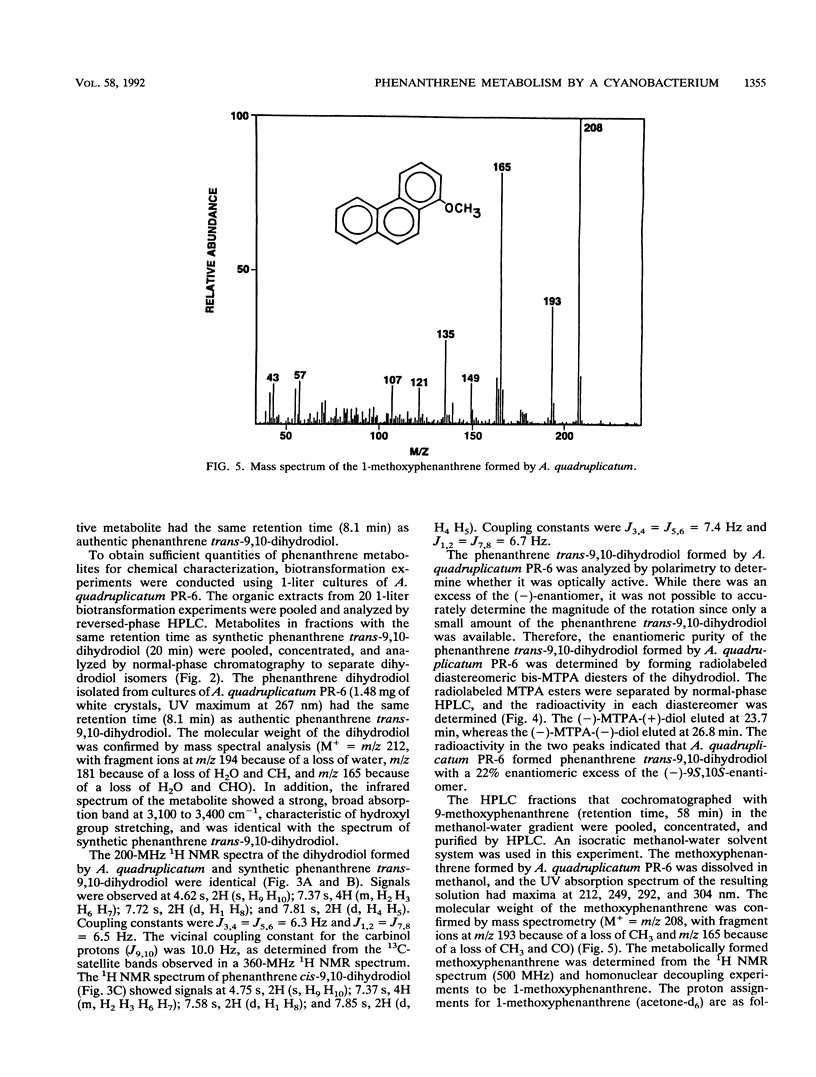
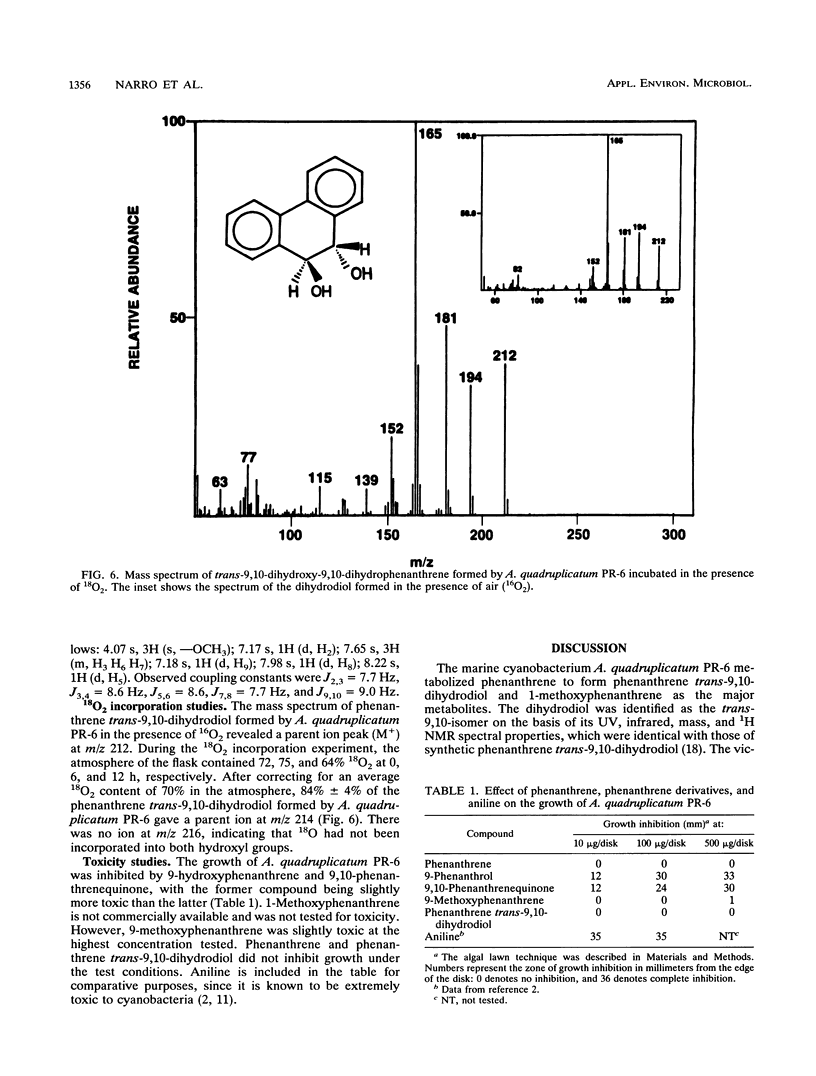
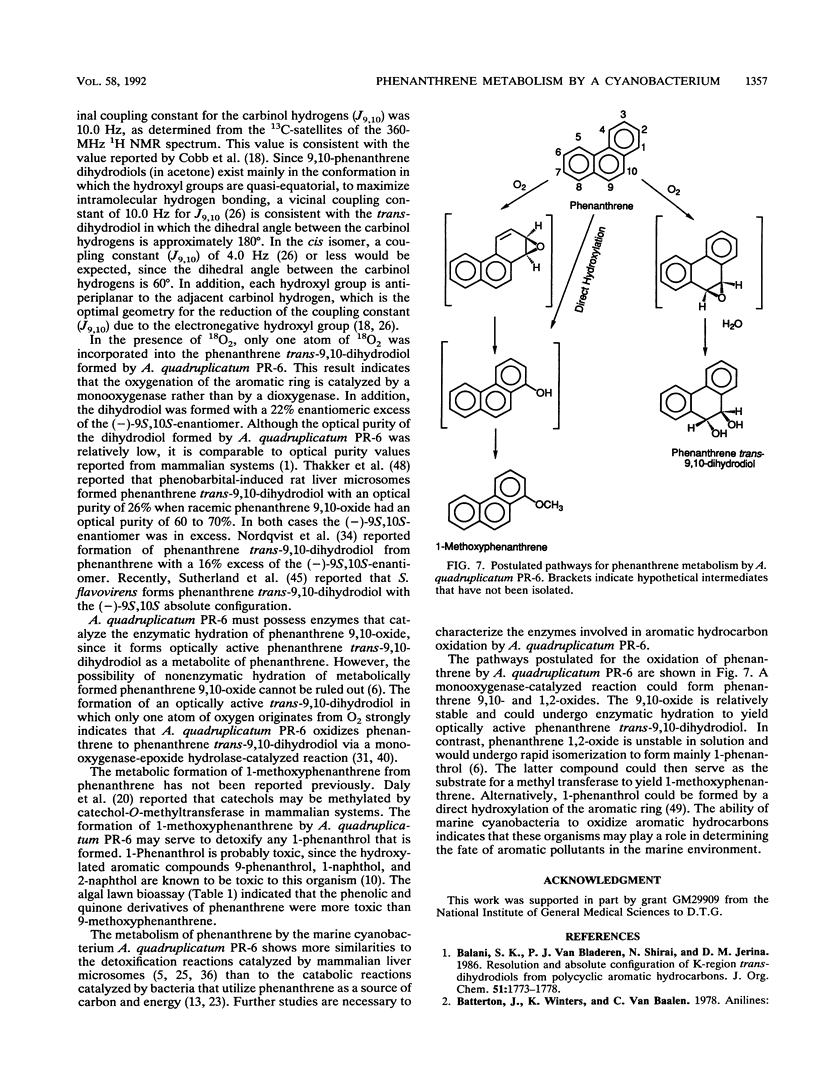
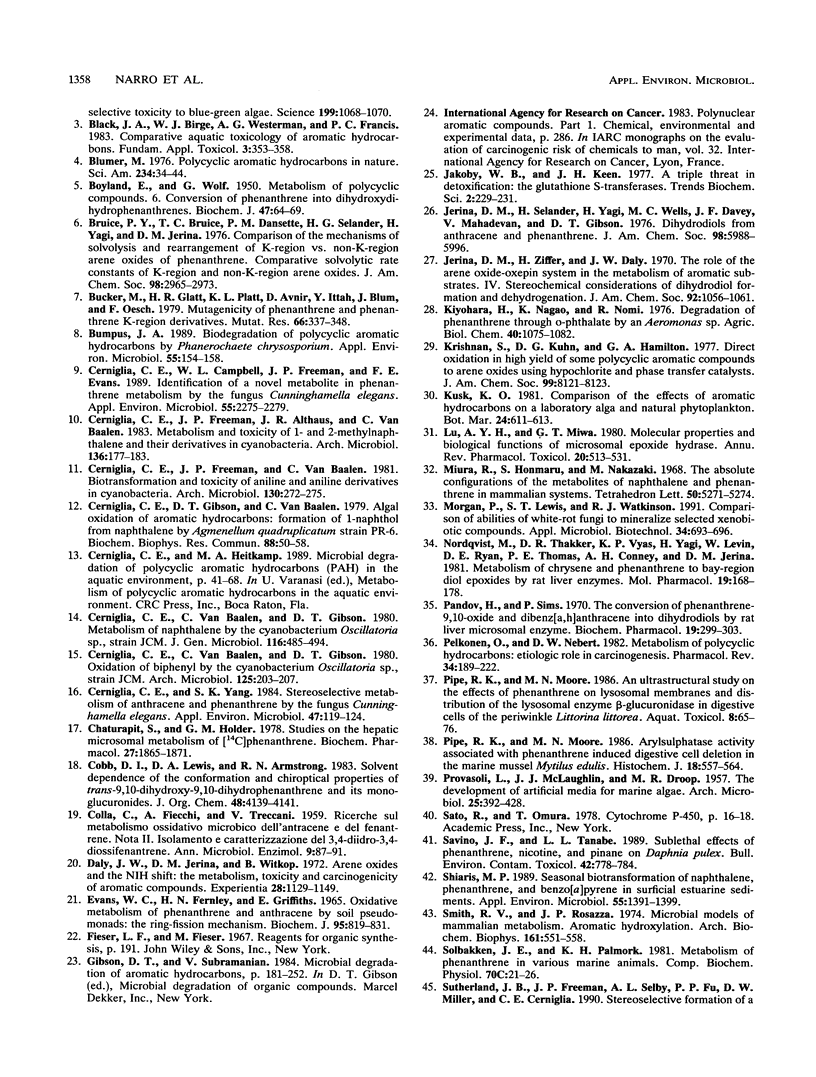

Selected References
These references are in PubMed. This may not be the complete list of references from this article.
- BOYLAND E., WOLF G. Metabolism of polycyclic compounds. 6. Conversion of phenanthrene into dihydroxydihydrophenanthrenes. Biochem J. 1950 Jun-Jul;47(1):64–69. doi: 10.1042/bj0470064. [DOI] [PMC free article] [PubMed] [Google Scholar]
- Black J. A., Birge W. J., Westerman A. G., Francis P. C. Comparative aquatic toxicology of aromatic hydrocarbons. Fundam Appl Toxicol. 1983 Sep-Oct;3(5):353–358. doi: 10.1016/s0272-0590(83)80004-9. [DOI] [PubMed] [Google Scholar]
- Bumpus J. A. Biodegradation of polycyclic hydrocarbons by Phanerochaete chrysosporium. Appl Environ Microbiol. 1989 Jan;55(1):154–158. doi: 10.1128/aem.55.1.154-158.1989. [DOI] [PMC free article] [PubMed] [Google Scholar]
- Bücker M., Glatt H. R., Platt K. L., Avnir D., Ittah Y., Blum J., Oesch F. Mutagenicity of phenanthrene and phenanthrene K-region derivatives. Mutat Res. 1979 Apr;66(4):337–348. doi: 10.1016/0165-1218(79)90044-2. [DOI] [PubMed] [Google Scholar]
- Cerniglia C. E., Campbell W. L., Freeman J. P., Evans F. E. Identification of a novel metabolite in phenanthrene metabolism by the fungus Cunninghamella elegans. Appl Environ Microbiol. 1989 Sep;55(9):2275–2279. doi: 10.1128/aem.55.9.2275-2279.1989. [DOI] [PMC free article] [PubMed] [Google Scholar]
- Cerniglia C. E., Freeman J. P., Van Baalen C. Biotransformation and toxicity of aniline and aniline derivatives of cyanobacteria. Arch Microbiol. 1981 Dec;130(4):272–275. doi: 10.1007/BF00425939. [DOI] [PubMed] [Google Scholar]
- Cerniglia C. E., Gibson D. T., Van Baalen C. Algal oxidation of aromatic hydrocarbons: formation of 1-naphthol from naphthalene by Agmenellum quadruplicatum, strain PR-6. Biochem Biophys Res Commun. 1979 May 14;88(1):50–58. doi: 10.1016/0006-291x(79)91695-4. [DOI] [PubMed] [Google Scholar]
- Cerniglia C. E., Van Baalen C., Gibson D. T. Oxidation of biphenyl by the cyanobacterium, Oscillatoria sp., strain JCM. Arch Microbiol. 1980 Apr;125(3):203–207. doi: 10.1007/BF00446877. [DOI] [PubMed] [Google Scholar]
- Cerniglia C. E., Yang S. K. Stereoselective metabolism of anthracene and phenanthrene by the fungus Cunninghamella elegans. Appl Environ Microbiol. 1984 Jan;47(1):119–124. doi: 10.1128/aem.47.1.119-124.1984. [DOI] [PMC free article] [PubMed] [Google Scholar]
- Chaturapit S., Holder G. M. Studies on the hepatic microsomal metabolism of (14C) phenanthrene. Biochem Pharmacol. 1978;27(14):1865–1871. doi: 10.1016/0006-2952(78)90034-5. [DOI] [PubMed] [Google Scholar]
- Daly J. W., Jerina D. M., Witkop B. Arene oxides and the NIH shift: the metabolism, toxicity and carcinogenicity of aromatic compounds. Experientia. 1972 Oct 15;28(10):1129–1149. doi: 10.1007/BF01946135. [DOI] [PubMed] [Google Scholar]
- EVANS W. C., FERNLEY H. N., GRIFFITHS E. OXIDATIVE METABOLISM OF PHENANTHRENE AND ANTHRACENE BY SOIL PSEUDOMONADS. THE RING-FISSION MECHANISM. Biochem J. 1965 Jun;95:819–831. doi: 10.1042/bj0950819. [DOI] [PMC free article] [PubMed] [Google Scholar]
- Jerina D. M., Selander H., Yagi H., Wells M. C., Davey J. F., Mahadevan V., Gibson D. T. Dihydrodiols from anthracene and phenanthrene. J Am Chem Soc. 1976 Sep 15;98(19):5988–5996. doi: 10.1021/ja00435a035. [DOI] [PubMed] [Google Scholar]
- Lu A. Y., Miwa G. T. Molecular properties and biological functions of microsomal epoxide hydrase. Annu Rev Pharmacol Toxicol. 1980;20:513–531. doi: 10.1146/annurev.pa.20.040180.002501. [DOI] [PubMed] [Google Scholar]
- Miura R., Honmaru S., Nakazaki M. The absolute configurations of the metabolites of naphthalene and phenanthrene in mammalian systems. Tetrahedron Lett. 1968 Oct;(50):5271–5274. doi: 10.1016/s0040-4039(00)89839-1. [DOI] [PubMed] [Google Scholar]
- Nordqvist M., Thakker D. R., Vyas K. P., Yagi H., Levin W., Ryan D. E., Thomas P. E., Conney A. H., Jerina D. M. Metabolism of chrysene and phenanthrene to bay-region diol epoxides by rat liver enzymes. Mol Pharmacol. 1981 Jan;19(1):168–178. [PubMed] [Google Scholar]
- PROVASOLI L., MCLAUGHLIN J. J., DROOP M. R. The development of artificial media for marine algae. Arch Mikrobiol. 1957;25(4):392–428. doi: 10.1007/BF00446694. [DOI] [PubMed] [Google Scholar]
- Pandov H., Sims P. The conversion of phenanthrene 9,10-oxide and dibenz[a,h]anthracene 5,6-oxide into dihydrodiols by a rat-liver microsomal enzyme. Biochem Pharmacol. 1970 Jan;19(1):299–303. doi: 10.1016/0006-2952(70)90349-7. [DOI] [PubMed] [Google Scholar]
- Pelkonen O., Nebert D. W. Metabolism of polycyclic aromatic hydrocarbons: etiologic role in carcinogenesis. Pharmacol Rev. 1982 Jun;34(2):189–222. [PubMed] [Google Scholar]
- Pipe R. K., Moore M. N. Arylsulphatase activity associated with phenanthrene induced digestive cell deletion in the marine mussel Mytilus edulis. Histochem J. 1986 Oct;18(10):557–564. doi: 10.1007/BF01675197. [DOI] [PubMed] [Google Scholar]
- Savino J. F., Tanabe L. L. Sublethal effects of phenanthrene, nicotine, and pinane on Daphnia pulex. Bull Environ Contam Toxicol. 1989 May;42(5):778–784. doi: 10.1007/BF01700403. [DOI] [PubMed] [Google Scholar]
- Shiaris M. P. Seasonal Biotransformation of Naphthalene, Phenanthrene, and Benzo[a]pyrene in Surficial Estuarine Sediments. Appl Environ Microbiol. 1989 Jun;55(6):1391–1399. doi: 10.1128/aem.55.6.1391-1399.1989. [DOI] [PMC free article] [PubMed] [Google Scholar]
- Smith R. V., Rosazza J. P. Microbial models of mammalian metabolism. Aromatic hydroxylation. Arch Biochem Biophys. 1974 Apr 2;161(2):551–558. doi: 10.1016/0003-9861(74)90338-5. [DOI] [PubMed] [Google Scholar]
- Solbakken J. E., Palmork K. H. Metabolism of phenanthrene in various marine animals. Comp Biochem Physiol C. 1981;70(1):21–26. doi: 10.1016/0306-4492(81)90073-3. [DOI] [PubMed] [Google Scholar]
- Sutherland J. B., Freeman J. P., Selby A. L., Fu P. P., Miller D. W., Cerniglia C. E. Stereoselective formation of a K-region dihydrodiol from phenanthrene by Streptomyces flavovirens. Arch Microbiol. 1990;154(3):260–266. doi: 10.1007/BF00248965. [DOI] [PubMed] [Google Scholar]
- Sutherland J. B., Selby A. L., Freeman J. P., Evans F. E., Cerniglia C. E. Metabolism of phenanthrene by Phanerochaete chrysosporium. Appl Environ Microbiol. 1991 Nov;57(11):3310–3316. doi: 10.1128/aem.57.11.3310-3316.1991. [DOI] [PMC free article] [PubMed] [Google Scholar]
- Thakker D. R., Yagi H., Levin W., Lu A. Y., Conney A. H., Jerina D. M. Stereospecificity of microsomal and purified epoxide hydrase from rat liver. Hydration of arene oxides of polycyclic hydrocarbons. J Biol Chem. 1977 Sep 25;252(18):6328–6334. [PubMed] [Google Scholar]
- Tomaszewski J. E., Jerina D. M., Daly J. W. Deuterium isotope effects during formation of phenols by hepatic monoxygenases. Evidence for an alternative to arene oxide pathway. Biochemistry. 1975 May 6;14(9):2024–2031. doi: 10.1021/bi00680a033. [DOI] [PubMed] [Google Scholar]
- Westkaemper R. B., Hanzlik R. P. A convenient reverse-phase liquid chromatographic assay for epoxide hydrase. Anal Biochem. 1980 Feb;102(1):63–67. doi: 10.1016/0003-2697(80)90317-6. [DOI] [PubMed] [Google Scholar]


